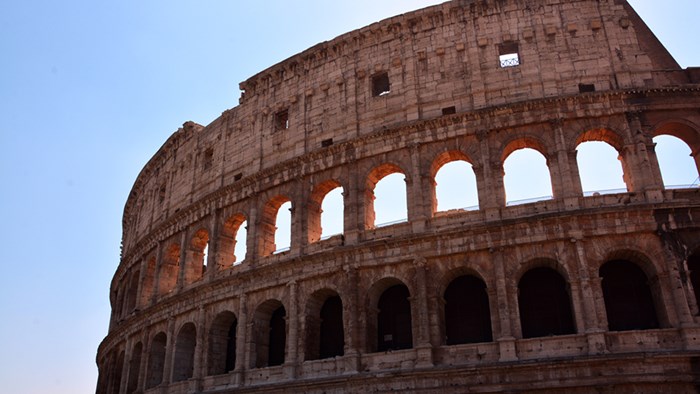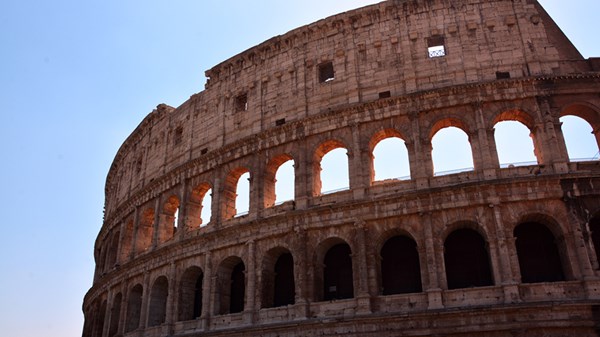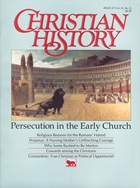
Early Christians expected suffering. Christ had died on the cross, so there was no higher honor than to imitate that death through accepting martyrdom (witness by one’s blood). The Jewish legacy portrayed, in writings such as the Fourth Book of the Maccabees, the glorious nature of death rather than renunciation of Israel; even without this, Christianity would inevitably have held the martyr’s death in high esteem. As the writer of 1 Peter expressed it, “If you suffer as a Christian, do not be ashamed, but praise God that you bear that name.” (4:16).
Why Were Christians Persecuted?
How was it that the church underwent such sacrifices? The Roman religion was not intolerant; Rome had accepted into its pantheon deities from the Italian tribes and from Asia Minor. In the provinces, the great territorial gods—such as Saturn in North Africa and Jehovah among the Jews—were accepted as “legal religion” on the grounds that their rites, even if barbarous, were sanctified by ancient tradition. Countless local gods and goddesses, worshiped by the ordinary inhabitants of the Greco-Roman world, were often provided with a classical equivalent name and worshiped as “Roman” deities.
Despite this toleration, by the early second century the Roman governor of Bithynia (on the Black Sea) had no hesitation in sending to immediate execution those who had been denounced as being Christians. The name alone was a sufficient death warrant.
Reasons for the persecution emerge from the record of Christianity’s first three centuries.
Fratricidal Strife
Persecution did not begin with the Roman authorities. The New Testament writings tell of fratricidal strife between Jews and Christians, the latter challenging the Jews by claiming to be “the New Israel.” In the early chapters of Acts, Stephen (7:57) and James, the brother of John the disciple (12:2), became victims of the Jerusalem mob and of King Herod Agrippa, respectively. Indeed, the writer of Luke-Acts appears to go out of his way to reassure the Roman authorizes of the loyalty and general value of the Christians and the hostility of the Jews toward them.
The persecutors and their motives changed in A.D. 64. On July 19 that year a great fire engulfed much of Rome; only four of the fourteen quarters of the city escaped damage. Suspicion immediately fell on Emperor Nero: was this a madcap way of clearing part of the city to make room for new, magnificent streets and buildings in his honor? Nero, however, managed to deflect blame first, apparently, on the Jews, who had a reputation for large-scale arson but also had friends at court; and then onto the Christians. Many Christians (perhaps including Peter) were seized, tortured, and done to death in the arena.
Tacitus, writing in c. 115, included an account of the incident in his Annales (XV, 44). Except for the manner of the Christians’ deaths, which he thought excessively cruel, he showed no sympathy for the Christians. Recording that “Christus, from whom the name [Christians] had its origin” was executed by “one of our procurators, Pontius Pilate,” Tacitus described the Christians as a “class hated for their abominations” and guilty of “hatred of the human race,” an accusation he also made against the Jews. Theirs was not a “religion” but a “deadly superstition,” and hence worthy of repression. Though there was no immediate sequel to Nero’s persecution, the fire forfeited any chance Christians might have had of being recognized as “legal religion” (religio licita) separate from Judaism.
Imperial Policies
Another 30 years pass before we hear of further action against the Christians, and then the evidence is not watertight.
Emperors were extremely suspicious of anything that seemed like “superstition” (for example, carrying a memento given by a Druid priest cost one Roman officer his life!). In 95–96, the emperor Domitian acted drastically against some members of the Roman nobility accused of “atheism” and “lapsing into Jewish customs.” It is not sure that Christianity was meant. However, Domitlla, the emperor’s kinswoman (neptis) who was exiled to the island of Pantelleria [near Sicily], was believed to have been a Christian. The accusation of “atheism”—denial of the existence and power of the gods—might point in that direction.
The veil is lifted, however, about 15 years later. In c. 112, Pliny was sent by the emperor Trajan (98–117) to Bithynia to restore the province from ravages caused by maladministration and corruption. He toured the province and when he reached the far east end, near Amastris, he encountered Christians. Pliny, though a lawyer by profession, had never been at a trial of Christians. The procedure he used was the same as for the vast majority of criminal cases in the province: cognitio extra ordinem, an arbitrary system of trial before a magistrate for offenses that fell outside the range of “statutory crimes” such as treason, forgery, or adultery.
As already mentioned, Pliny condemned to immediate execution those who confessed to being Christians, “for I held no question that whatever it was that they admitted, in any case obstinacy and unbending perversity deserve to be punished.” Christianity itself was punishable, but the defiant, martyr-attitude of the accused left Pliny in no doubt that his action was right.
Pliny’s difficulties arose when individuals agreed that they had been Christians once but were so no longer, and his letter to the emperor indicated his preference for lenience toward them. Trajan responded in an ambiguous but fair-minded way. Christians were “not to be sought out” (i.e., treated like common criminals). If they recanted and “worshiped our gods,” they were to be freed, but those who persisted must be punished. Anonymous denunciations, however, were to be rejected as being “a bad example and unworthy of our times.”
Twelve years later (in 124–125), Christian gained a further concession. Anti-Christian riots had broken out in the province of Asia (western Asia Minor) in 122–123, and the governor had written to Emperor Hadrian for advice. In response, Hadrian’s rescript (imperial order) allowed cases against Christians to be brought to trial, but ordered that the Christians had to be proven guilty of illegal acts before they could be condemned. Once again, “slanderous attacks” against Christians were forbidden. The rescript helped protect Christians, for now the emphasis was less on their name than on specific misdeeds. Christians might be unpopular, and their cult technically illegal, but it would take a bold man to file an accusation that, if in any way flawed, could rebound with serious consequences. An accuser also had to await the arrival of the one senior of ficial (the proconsul) able to try a capital case in the large province of Asia. No wonder Justin Martyr attached the text of Hadrian’s rescript to the end of his First Apology, written c. 155.
Precarious Toleration
Between 125 and 160, Christians enjoyed a precarious toleration. Few martyrdoms are recorded in this era of prosperity that marked the climax of the Greco-Roman achievement.
With the accession of Marcus Aurelius as emperor in 161, however, the situation changed. First, the Christians were becoming exceedingly unpopular; they were blamed for causing natural disasters by refusing to worship the deities that protected communities. Christians were also accused of immorality, unnatural vice, and black magic, all calculated to bring the rest of the population into peril.
An urban mob demanded the arrest of Polycarp, bishop of Smyrna, during what the ecclesiastical historian Eusebius of Caesarea termed “great persecutions that disturbed the province of Asia” (perhaps in February 156, but more likely 166–69). Other Christians had been seized, tried, and executed before Polycarp was arrested. One, a Phrygian, had rushed toward martyrdom—only to recant at the sight of the beasts in the amphitheater.
Polycarp was brought before the proconsul, who begged him to have respect for his great age (he was probably nearly 100), saying, “Swear by the genius of Caesar” and denounce “the atheists.” But Polycarp, seeing “the lawless heathen” in the amphitheater, “waved his hands at them, and looked up to heaven with a groan and said, ‘Away with the atheists.’ ” The proconsul persisted, “Swear, and I will release you. Curse Christ.” And Polycarp replied, “Eighty-six years have I served him, and he has done me no wrong; how can I blaspheme my King who saved me?” He was condemned to death and burned alive.
The story shows the efforts made by an average, reasonable administrator in the second century to persuade a Christian leader not to sacrifice his life, and the latter’s complete commitment to Christianity, even in the face of death. Between the two outlooks there was little room for compromise.
Later in Marcus’s reign, in c. 175, we hear of “new decrees,” probably emanating from the proconsul of Asia, making it easier for enemies to denounce Christians and seize their property. In one terrible pogrom at Lyon in Gaul [modern France] in 177, forty-eight Christians were done to death in the amphitheater.
Rising Tension
A new dynasty, the Severan Dynasty, seized power in 193, at a crucial moment in the church’s relations with the Empire. Though it remained illegal, the church was now much stronger than in the previous century. Christians were consolidated around urban communities governed by bishops, who were in frequent contact by letter with one another. The church had its own liturgy, its own sacred writings separate from those of the Jews, and established rules of faith on which orthodox doctrines could be built. It also had begun to acquire property (the Areae, or cemeteries; and in Rome, the earliest catacombs date to c. 200). Most important, the church had recovered its missionary urge, which after St. Paul and his disciples seems to have diminished through much of the second century. The result was great tension between Christians and pagans in provinces where the church was strong.
The dynasty’s individual emperors—Septimius Severus (193–211), Caracalla (211–217), Elagabalus (218–222), and Alexander Severus (222–235)—do not seem to have been personally ill-disposed toward Christians. In Alexander Severus’s reign, the first building identifiable as a house-church was erected in the frontier town of Dura-Europos on the River Euphrates. The emperors’ individual dispositions, however, were nullified by the wave of anti-Christian feeling in Carthage, Alexandria, Rome, and Corinth from about 202 to 210. The recorded victims of persecution were mainly converts—such as Perpetua and Felicitas in Carthage (martryed March 7, 203), or the disciples of Origen in Alexandria. The bishops and clergy seem not to have been affected.
The end of the Severan Dynasty in 235 brought another brief period of persecution under its supplanter, Maximinus Thrax (235–238), aimed, according to Eusebius, against the “leaders of the Church.”
This was followed, however, by 12 years of calm in which the church expanded, extended its catacombs in Rome, and through its great teacher Origen (186–254), established for the first time an intellectual superiority over its pagan contemporaries. Origen, however, perceived the danger of the situation. There might not have been many martyrs to date, but persecution, if it came now, would be on a worldwide scale. He was right.
Empire-Wide Persecution
Under the emperor Decius (249–251) the church experienced what, in retrospect, was its most severe test. Decius had come to power at a moment of grave military threat from the Goths, and economic and social decline in the cities. He blamed his predecessor, Philip, for military incompetence and the Christians, whom he believed Philip had favored, for the breakdown of morale in the Empire. His remedy was an explicit return to former Republican virtues (Roman mores) and the association of all inhabitants of the Empire with the emperor’s yearly sacrifice to the gods of Rome on the Capitol. Decius combined this move, evidently, with an order (probably in December 249) to seize leading Christians. By January 20, 250, Pope Fabian had been tried before the emperor himself and sentenced to be executed.
The authorities went to great lengths to ensure compliance. In major cities, such as Carthage, commissions saw that individuals did perform sacrifice and punished those who refused. In Egypt, at least, there were commissioners in the country areas, and 44 of the certificates (libelli) have survived. They follow a set pattern. One reads, “To those appointed to see the sacrifices: From Aurelia Charis of the Egyptian village of Theadelphia. I have always continued to sacrifice and show reverence to the gods, and now, in your presence, I have poured a libation and sacrificed and eaten some of the sacrificial meat. I request you to certify this for me below.” The date and official signatures follow, occupying several lines of papyrus. Charis retained one certificate for herself, and the other was deposited in the official archives, so one can imagine the bureaucratic nightmare the order caused.
Contemporaries, both pagan and Christian, and Christian historians of the next century indicate that Decius’s measures were initially very successful. “All cowered with fear,” as one contemporary writer said of the Christians in Alexandria. Many fled; few wished to defy the emperor openly. Alexandria and Carthage saw massive apostasies. In Smyrna, the bishop himself performed sacrifice. Those who defied the authorities, like the presbyter Pionius of Smyrna, were often regarded as simpletons or fanatics eager to throw away their lives. The edict caused deep divisions among Christians, moreover, that brought merriment to pagan authorities.
Decius’s main aim had been to secure universal support by a sacrifice to the gods to “restore Roman liberty.” Once that had been achieved, by the early months of 251, the persecution was over. Decius died in June 251 on a campaign against the Goths, and Bishop Cyprian, who had fled, returned to Carthage to aid demoralized and disorganized congregations.
The church recovered its adherents rapidly but faced problems: what to do about the multitudes who had lapsed, and how to treat the Novatianist schism in Rome and North Africa, which had repercussions throughout much of the church. The Novatianists, according to Eusebius, called themselves “the pure.” They would not allow those who had given in during the persecution to return to the church. Their movement foreshadowed more permanent division in the Christian church between those who put its integrity above all other values, and those who regarded universality (the Katholike) as all important.
“Sacrilegious Instigators”
The new emperor, Valerian (253–60), at first tolerated the Christians but in the summer of 257 suddenly altered his attitude. The emperor’s policy was not to destroy the Christian church but to bring it into conformity with public rites (aimed at safeguarding the empire in time of peril). In July-August he sent orders to deport Cyprian, bishop of Carthage, and Dionysius, bishop of Alexandria. Other bishops were sent to the mines. In addition, Christian places of worship and cemeteries were closed, and anyone entering did so at risk of execution.
For nearly a year there was an uneasy calm. The Christians, however, were not cowed as they were a few years before. We learn of numbers of visitors to Curubis, where Cyprian was living; of forbidden Christian assemblies in a suburb of Alexandria; and of proselytizing by Dionysius where he had been exiled.
The emperor’s patience broke. Around July 258, Valerian ordered that bishops, priests, and deacons be executed, that church property be confiscated, that socially superior (honorati) laity lose their privileges and imperial civil servants (Caesariani) be reduced to slavery (a status from which many had emerged).
In some parts of the Empire this persecution of 258 259 was the bloodiest the church endured. On August 6 Pope Sixtus II was discovered conducting a service in the Catacomb of Praetextatus and was martyred, as were all seven of his deacons. Next month, Cyprian was brought from his place of exile to face the ailing governor, Galerius Maximus. Once again Cyprian refused to perform sacrifice. In words that summed up the authorities’ case against the Christians, the proconsul said, “You have lived a sacrilegious life, and you have gathered around yourself many vicious men in a conspiracy. You have set yourself up as an enemy of the Roman gods and of their sacred rites. And the pious and most religious emperors Valerian and Gallienus Augusti, and Valerian, the most noble Caesar, have been unable to bring you back to the observance of their own sacred rituals. Therefore, having been apprehended as the instigator and ringleader of a criminal conspiracy … you will be executed.” Conspiracy, illegal association, enmity toward the gods of Rome—these charges formed the basis for the persecutions during the first three centuries.
Lull Before the Storm
Valerian’s death brought more than 40 years of peace (260–303). Christian could still be arrested, however. For example, a Christian soldier, Marinus, lost his life when a jealous fellow soldier found that Marinus was to be promoted to the rank of centurion and denounced him as a Christian. Yet bishoprics multiplied, and church building seems to have gone on unhindered. In the imperial capital at Nicomedia (on the opposite side of the Bosporus to Constantinople), the Christian church stood in full view of the imperial palace. More important, the church now became a movement of the countryside as well as of the towns. In his Ecclesiastical History, Eusebius quoted Dionysius of Alexandria, who hailed Gallienus as an emperor under whom “the monarchy, as it were, put aside its old age and cleansed itself from its former wickedness and now blossoms forth in fuller bloom.… ”
Final, “Great Persecution”
In 303, however, came 10 years of persecution, the “Great Persecution” as it became known. How and why, after 43 years of peace, did this happen?
First, while the church appeared to be accepted, opposition to it was never far below the surface. Since 270 the pagans, inspired by the Neo-Platonist philosopher, Porphyry, had begun to mount a serious intellectual assault on Christianity. “The evangelists,” Porphyry wrote in 15 books Against the Christians (c. 280–290) “were the inventors, not the historians, of those things they record about Jesus.” This propaganda war between Christian and pagan champions intensified in the 290s.
Second, in 284 Diocletian seized power by a coup d’etat and survived to become one of the greatest conservative reformers of all time. In March 286 he appointed a comrade-in-arms, Maximian, as co-emperor (Augustus) in the West; and on March 1, 293, the two Augusti appointed two other military men, Constantius and Galerius, as their assistants, or Caesars. The emperors’ ideal was to return to the traditional values of Rome. They imposed a uniform system of administration, currency and, in 301, prices throughout the Empire. Uniformity and discipline were the watchwords of the age, yet Christian remained a standing challenge to the unifying and conservative ideals of the emperors.
Persecutions might not have occurred, however, but for the fortunes of war. In 296 Caesar Galerius, who was strongly anti-Christian, won a decisive victory over the Persians. With his victory his influence over Diocletian increased. Diocletian’s family contained some who were pro-Christian, and he was unwilling to act against the Christians. But his hand was forced, partly by Galerius’s steady pressure and partly by anti-Christian propaganda from some provincial governors. Between 298 and 302 the civil service and army were gradually purged of Christians Late in 302 the emperors visited the shrine of Apollo at Didyma and the oracle complained of the baneful influence of the Christians (“the just on earth”) in its pronouncements. The die was now cast. On February 23, 303, the Feast of Terminalia, repression would start.
Churches were destroyed, Christian services banned, and the Scriptures seized and burned. Christians in high places lost civil rights, and “those in households” (perhaps meaning, “private citizens”) were deprived of their liberty. One concession Diocletian secured: no bloodshed.
A second edict imposed an obligation on all clergy to sacrifice, but the prisons became too full, and in the autumn of 303 this was modified and most of those imprisoned for refusing were released.
So far the persecution had not been as severe as under Valerian. Scriptures were seized, but among Christians there was often consternation and grudging compliance. Only a minority of determined souls held out. Years later, the “day of handing over” was remembered as a day of disaster by the North African Christians.
In 304, with Diocletian ill in Rome, Galerius seized his chance and imposed a universal obligation to sacrifice on pain of death. Up to then only the clergy had been involved directly; now the pressure was on every Christian. The number of martyrs increased, as did the defiance of the Christians. One inscription from a North African church lists 34 men and women who “suffered under the laws of the divine emperors Diocletian and Maximian.” In Phrygia a whole community was wiped out, and Egypt saw eight years of ruthless repression, which among the Coptic Christians earned the reign of Diocletian the title “The era of the martyrs. ”
A Grudging Concession
This phase ended on May 1, 305, when Diocletian and his western colleague, Maximian, formally abdicated, to be succeeded by Galerius and Constantius respectively. In the West, Constantius took no further action, and on his death, his son Constantine was proclaimed emperor by his troops. In the next five years Constantine gradually increased his authority, and though an adherent of Apollo, followed his father’s policy of toleration toward Christians.
In the East, however, Galerius renewed persecution, accompanied by anti-Christian propaganda and a great effort to reorganize paganism along Christian hierarchical structures.
It was too late. Steam gradually ran out of the enforcement of the edicts, and no martyrs are recorded in this phase after 310. In April 311, Galerius, realizing that he was dying, decided that enough was enough and revoked the edicts of persecution. In the spirit of Diocletian’s reform, he wrote, “We wished previously, always acting for the good of the commonwealth, to correct all things according to the ancient laws and public discipline of the Romans.” However, too many Christians had failed to conform, and rather than they should not worship any god, “they might henceforth exist again. Their meeting houses were to be restored,” and their prayers “for our good estate” were asked. This last request was in vain, for Galerius died six days later. Galerius’ concession of failure was grudging but decisive. The Empire could not be preserved by the “immortal gods” with the Christian God possessing a veto over their powers.
In the spring of 312, Constantine entered on a final bid for supremacy in the West. Campaigning against his rival, Maxentius, through north and central Italy, he reached within five miles of Rome on October 27. That night he had a vision or dream that convinced him that his own destiny lay with Christianity. Next day he defeated Maxentius’s superior forces and entered Rome in triumph. In February 313 Constantine met Licinius (who had succeeded to Galerius’ European dominions), and in a document that has become known as the Edict of Milan formally ended the persecution. All individuals were to be free to follow their own consciences. In fact, the Edict proved to be the deathknell of the immortal gods. Eleven years later (in 324), Constantine defeated Licinius and proclaimed his adherence to Christianity and his aim that Christianity should become the religion of the Empire now united under his sole rule. The church had triumphed.
Why the Christians Triumphed
Why had the Christians won?
First, they had become too strong to be defeated. In some provinces, such as Bithynia and Cyrenaica [today, northern Egypt and Libyal, they may already have formed a majority, and they were well organized.
Further, Christians attracted people, as a Neo-Platonist philosopher explained c. 300, by their religion’s “simplicity,” its direct moral teaching and promise uncomplicated by its rivals’ mythology.
More than that, Christianity had never lost its martyr spirit. As one contemporary (Lactantius) explained, “There is another cause why God permits persecutions to be carried out against us, that the people of God may be increased.” People rejected the old gods because of the cruelties perpetrated in their names. People inquired what was so good that it seemed preferable to life itself, “so that neither loss of goods, nor of the light, nor bodily pain or tortures deter them.” In Egypt in 311–312, Eusebius of Caesarea was an eyewitness of the final horrors of Maximinus’s persecution. He writes that “we ourselves beheld, when we were at these places, many [Copts] all at once in a single day, some of whom suffered beheading, others punishment by fire, so that the murderous axe was dulled, and worn out, was broken in pieces, and the executioners grew utterly weary.… It was then that we observed a most marvelous eagerness and a truly divine power and zeal in those who placed their faith in the Christ of God. Thus, as soon as sentence was given against the first, some from one quarter and others from another would leap up to the tribunal before the judge and confess themselves Christians.… ”
Popular opinion had been changing in favor of Christianity in the previous 30 years. Against such spirit the pagan authorities were powerless. They might sometimes win intellectual combats, proving Plato was a cleverer man than St. Paul, but those who regarded death as liberation had the last word.
Dr. Everett Ferguson is professor of Bible at Abilene Christian University and author of Backgrounds of Early Christianity (Eerdmans, 1987)
Copyright © 1990 by the author or Christianity Today/Christian History magazine.
Click here for reprint information on Christian History.

Support Our Work
Subscribe to CT for less than $4.25/month






























